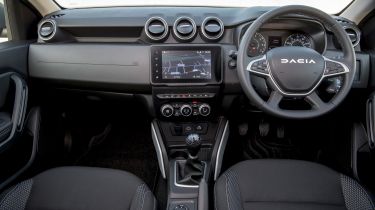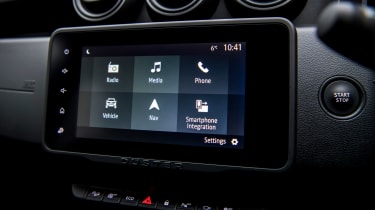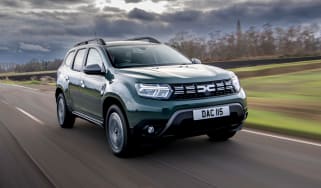Dacia Duster review - Interior & comfort (2018-2024)
The Dacia Duster is now more comfortable and refined than before, but not as plush as more expensive rivals
Inside, the Dacia Duster has received a makeover in terms of both comfort and styling. The SUV has come a long way since it was introduced and its interior reflects this: build quality is good and the materials feel hard-wearing, if not particularly luxurious. The Duster’s seats are more comfortable than before, offering better support, extra padding and more adjustability.
The Dacia Duster easily holds its own against pricier rivals like the Renault Captur and SEAT Arona, but don’t expect quite the same level of polish as those cars. However, despite its low price, the Duster makes for perfectly comfortable everyday transport.
Dacia Duster dashboard
Dacia has given the latest Duster a refreshed dashboard that incorporates a higher-set infotainment screen, ‘piano-type’ buttons and better-quality materials. It’s not the most exciting design but makes up for its plain appearance with a reassuringly solid feel. The conventional dials behind the steering wheel are easy to read, while all of the controls are within easy reach – Dacia boasts that its infotainment system has one of the shortest viewing distances (from the driver’s seat) on the market.
Steering wheel audio controls mounted behind the wheel are lifted from other Renault models, and are clear and very simple to use, but the sound system is tinny and fights a losing battle with road noise at higher speeds. There are also three dials to control the air-conditioning and ventilation system, which are far easier to use on the move than on-screen graphics and a touchscreen.
More reviews
Bi-Fuel Dusters are fitted with an aftermarket-looking LPG gauge and button to the right of the steering wheel. This shows the amount of LPG in the 35-litre tank and allows the driver to switch between LPG and petrol, once the system has reached its operating temperature. It will automatically switch the fuel supply back to petrol when the LPG tank is empty.
Many modern cars come with glitzy touchscreens, digital instrument panels and space-age head-up displays. Unsurprisingly, given Dacia’s no-nonsense nature, the Duster goes without the latter two completely, and even its touchscreen offers just the bare minimum.
There’s no built-in navigation, so you’ll have to hook up a smartphone; that’s no bad thing, because Apple CarPlay and Android Auto tend to offer superior route-planning software than the majority of built-in navigation systems.
The Duster’s eight-inch screen isn’t particularly sharp to look at or responsive to touch, but it gets the job done adequately. A secondary benefit of offering so few standard features is that it’s quick and easy to get familiar with the layout.
Equipment
The simple-to-understand Dacia Duster range is split into four main trim levels: Essential, Expression, Journey and Extreme (previously, Access, Essential, Comfort, Prestige and Extreme SE were available). The Access trim has been discontinued, and was refreshingly basic: there was no radio or climate control as standard, and you had to make do with 16-inch steel wheels and a single-piece folding rear seat. Electric front windows, black plastic bumpers, stop-start and a locking central differential (on four-wheel-drive versions) came as standard, but that was about it. All models have LED daytime running lights, though.
Despite now being the entry-level model, the Essential trim gets DAB radio, air-conditioning, 16-inch silver steel wheels, 60:40 split rear seats, black roof bars, front fog lights, a height-adjustable driver’s seat, plus Bluetooth connectivity, auxiliary input, a USB connection for MP3 players and cruise control with a speed limiter.
Expression adds an eight-inch colour touchscreen for the infotainment system, navigation, a reversing camera and Apple CarPlay and Android Auto. It also comes with 16-inch alloy wheels, satin chrome exterior body styling, rear tinted windows and a host of interior trim upgrades, including a leather steering wheel and a chrome gearknob. Electric rear windows and heated, power-adjustable door mirrors also feature. Unless you want your Duster to be a utilitarian workhorse, this is probably the trim to pick.
The Journey trim adds trendy 17-inch alloy wheels, grey exterior trim, upgraded upholstery, a 'Multiview' camera system, wireless smartphone connectivity, climate control, heated seats and keyless entry. An Extreme trim now sits above Journey, carrying over all of the standard equipment and adding an exclusive Cedar Green paint colour with Copper Brown mirror caps, wheel badges and other trim highlights. It's also fitted with black 17-inch alloy wheels and a shark fin antenna in the same colour. Inside, there are Copper Brown accents around the door trims, air vents and gear lever. This brings a welcome freshness to the cabin, so it’s worth the uplift over Journey.
A top-spec Duster may seem like a contradiction in terms, but the difference on a PCP finance deal means upgrading often comes with minimal extra outlay. It's also worth remembering that a top-spec Dacia Duster can still work out much cheaper than rivals, too, even if they're in more modest trims.
Options
In a world of long and convoluted options lists, the Duster’s is pleasingly simple. One of the few options is an emergency spare wheel for £250, offered on all versions. Metallic paint is also available for around £600.
A range of accessory packs is also offered. Highlights include the Protection Pack, adding an alarm, boot sill protector, mud flaps and boot liner for around £400. A Pet Pack adds a grille between the boot and rear seats, along with a boot liner for around £250. A swan neck tow bar can also be added for around £350.















